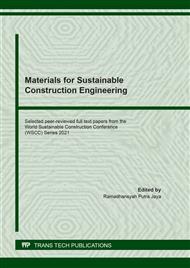[1]
BPS East Kalimantan Province, Data Penduduk Kalimantan Timur,, 2021. [Online]. Available: https://kaltim.bps.go.id.
Google Scholar
[2]
F. N. Abdi, H. Sutanto, and A. Al Fitrah, Kuat Tekan Beton dengan Rasio Volume 1 : 2 : 3 Menggunakan Agregat di Kalimantan Timur (Senoni, Long Iram, Batu Besaung, Penajam dan Sambera) Berdasarkan SNI 032834-2000,, in Seminar Nasional Teknologi V, 2019, vol. 1, p.182–190.
DOI: 10.23960/jpi.v1n2.46
Google Scholar
[3]
F. N. Abdi, J. Alkas, and A. Setiawan, Uji Kelayakan Agregat Muara Wahau, Santan, Senoni, Batu Besaung sebagai Material Subbase,, in Proseding Seminar Nasional Teknologi V, 2019, p.148–156.
Google Scholar
[4]
Eswan, S. A. Adisasmita, M. I. Ramli, and S. Rauf, The effect of water immersion on compressive strength of Senoni stone, East Kalimantan,, in IOP Conference Series: Earth and Environmental Science, 2020, vol. 419, no. 1, p.1–5.
DOI: 10.1088/1755-1315/419/1/012103
Google Scholar
[5]
R. Pratiwi, Rahmat, and S. M. Devi, Analisis Kuat Tekan Beton 30 Mpa Menggunakan Agregat Lokal Kalimantan Timur (Agregat Labangka Dan Pasir Kandilo),, 2019, p.83–89.
DOI: 10.20961/jrrs.v2i1.24316
Google Scholar
[6]
N. A. H. Hidayah, M. Hasanan, and P. J. Ramadhansyah, Effect of coarse aggregate sizes on properties of Porous Concrete Paving Blocks,, Adv. Mater. Res., vol. 911, p.433–437, (2014).
DOI: 10.4028/www.scientific.net/amr.911.433
Google Scholar
[7]
A. V. R. Ashish Guruji, Urban Storm Water Management Through Pervious Concrete Pavement,, Researchgate, no. April, p.2–4, (2015).
Google Scholar
[8]
M. Chopra, M. Wanielista, J. Spence, C. Ballock, and M. Offenberg, Hydraulic Performance of Pervious Concrete Pavements,, Proc. 2016 Concr. Technol. Forum., no. 407, p.1–15, (2016).
Google Scholar
[9]
M. Kováč and A. Sičáková, Pervious concrete as an environmental solution for pavements: Focus on key properties,, Environ. - MDPI, vol. 5, no. 1, p.3–9, (2018).
DOI: 10.3390/environments5010011
Google Scholar
[10]
C. W. Tang, C. K. Cheng, and C. Y. Tsai, Mix design and mechanical properties of high-performance pervious concrete,, Materials (Basel)., vol. 12, no. 16, (2019).
DOI: 10.3390/ma12162577
Google Scholar
[11]
T. D. Paul, L. L. Michael, A. J. David, P. D. Tennis, M. L. Leming, and D. J. Akers, Pervious Concrete Pavements, vol. Portland C, no. January 2004. (2004).
Google Scholar
[12]
A. Sičáková and M. Kováč, Relationships between functional properties of pervious concrete,, Sustain., vol. 12, no. 16, (2020).
DOI: 10.3390/su12166318
Google Scholar
[13]
R. Mahalingam and S. V. Mahalingam, Analysis of pervious concrete properties,, Gradjevinar, vol. 68, no. 6, p.493–501, (2016).
Google Scholar
[14]
A. A. M. Sharif, S. Shahidan, H. B. Koh, A. Kandash, and S. S. Mohd Zuki, Strength development of pervious concrete containing engineered biomass aggregate,, IOP Conf. Ser. Mater. Sci. Eng., vol. 271, no. 1, (2017).
DOI: 10.1088/1757-899x/271/1/012002
Google Scholar
[15]
Y. Aoki, S. Ravindrarajah, and H. Khabbaz, Properties of pervious concrete containing fly ash,, Road Mater. Pavement Des., vol. 13, no. 1, p.1–11, (2012).
DOI: 10.1080/14680629.2011.651834
Google Scholar
[16]
H. N. H. Roshni J John, Effect of Aggregate Grading and Cementitious By-product on Performance of Pervious Concrete,, Int. J. Innov. Res. Sci. Eng. Technol., vol. 4, no. 8, p.6890–6897, (2015).
DOI: 10.15680/ijirset.2015.0408026
Google Scholar
[17]
P. J. Ramadhansyah et al., Strength and Porosity of Porous Concrete Pavement Containing Nano Black Rice Husk Ash,, IOP Conf. Ser. Mater. Sci. Eng., vol. 712, no. 1, (2020).
DOI: 10.1088/1757-899x/712/1/012037
Google Scholar
[18]
M. U. Maguesvari and V. L. Narasimha, Studies on Characterization of Pervious Concrete for Pavement Applications,, Procedia - Soc. Behav. Sci., vol. 104, p.198–207, (2013).
DOI: 10.1016/j.sbspro.2013.11.112
Google Scholar
[19]
T. Mulyono and . A., Sustainable Material for Local Road Using Pervious Concrete with Various Aggregates,, KnE Soc. Sci., vol. 3, no. 12, p.65, (2019).
DOI: 10.18502/kss.v3i12.4074
Google Scholar
[20]
ACI 552R-10, Report on pervious concrete, American concrete institute. (2010).
Google Scholar
[21]
Badan Standardisasi Nasional, SNI 03-1974-1990 Metode Pengujian Kuat Tekan Beton,, Badan Stand. Nas. Indones., (1990).
Google Scholar
[22]
SNI 03-4154-1996, Metode Pengujian Kuat Lentur Beton dengan Balok Uji Sederhana yang Dibebani Terpusat Langsung, no. 19. Jakarta, (1996).
Google Scholar
[23]
SNI 03-2491, Metode pengujian kuat tarik belah beton,, Badan Standar Nas. Indones., p.14, (2002).
Google Scholar
[24]
A. E. A. El-maaty, Establishing a Balance Between Mechanical and Durability Properties of Pervious Concrete Pavement,, vol. 1, no. 2, p.13–25, (2016).
Google Scholar


